What do the nuns do every day? The nuns do much more than study and pray.
The seven nunneries in India that the Tibetan Nuns Project supports through our sponsorship program are complex institutions that require a lot of work to run smoothly. The largest of them, Dolma Ling Nunnery and Institute, functions like a non-sectarian monastic university and is home to almost 250 nuns plus staff. Just feeding that many people each day is a challenge.
This blog post is a photo essay showing some of the many tasks that the nuns at the various nunneries do in addition to their studies and their Buddhist practice.
The nuns at Dolma Ling Nunnery and Institute have been keeping cows for the past 20 years. The nuns have 7 milking cows, as well as five calves and two older cows. The cows provide milk to meet Dolma Ling’s daily needs. Many of the nuns grew up as nomads in Tibet, so daily milking presents no problem.
At Sherab Choeling Nunnery in the remote Spiti Valley, the nuns work hard during the summer months to grow food for the long, harsh winter. Several years ago, people from the nearby village donated a piece of land to the nuns where they now grow spinach, beans, and potatoes. The nuns have three greenhouses where they mostly grow spinach. The head nun has also donated her share of a field to the nunnery so the nuns have also been able to grow peas and wheat.
Nuns from Shugsep Nunnery prepare tsampa by roasting barley and then grinding it into flour. Tsampa is a staple of the Tibetan diet and is mixed with butter tea. There’s a tradition of throwing pinches of tsampa in the air during many Tibetan Buddhist rituals.
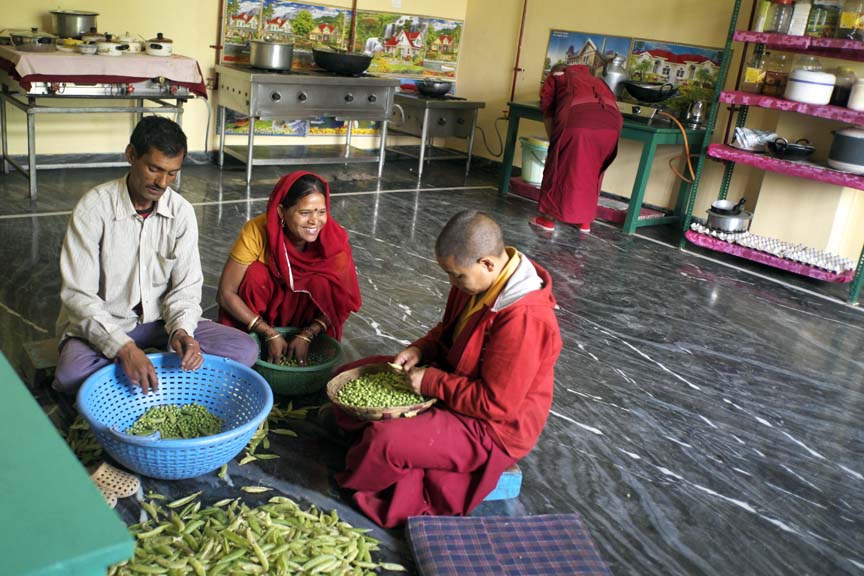
Shelling peas with helpers from the local community in the kitchen at Tilokpur Nunnery. Photo courtesy of Brian Harris.
Tilokpur Nunnery is the oldest Kagyu nunnery outside of Tibet. It provides housing and education to over 60 nuns and overlooks a small town in the lush foothills of the Himalayas of Himachal Pradesh in northern India. Here, in the Tilokpur kitchen, a nun and local helpers shell peas. As you can imagine, preparing peas for about 60 people takes a bit of time.
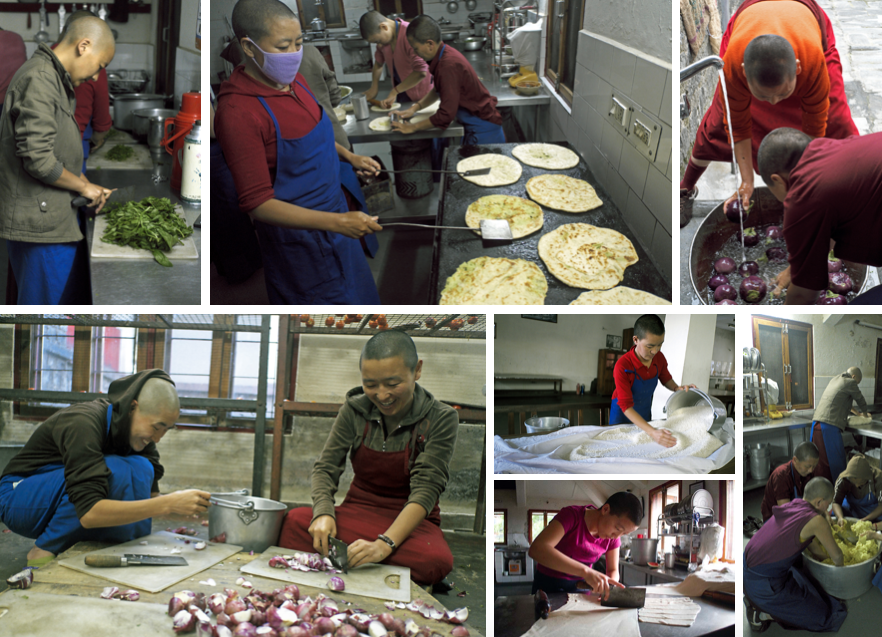
Collage of photos showing food preparation and cooking at Dolma Ling Nunnery. Photos courtesy of Brian Harris.
At Dolma Ling Nunnery you have to get up very early to prepare breakfast for 230 nuns. Nuns on kitchen duty start preparing breakfast at 3 in the morning. All the food is vegetarian and is prepared by the nuns themselves.
Dolma Ling nuns use colored butter to make elaborate sculptures to decorate a traditional chemar bo, an open, decorated box used at Losar or Tibetan New Year. The art of making sculptures out of yak butter has been practiced in Tibet for over 400 years. At Dolma Ling the nuns have been learning how to make butter sculptures from their excellent teacher Gen. Karma-la. He finds that the nuns, with their nimble fingers, their keen sense of color and design, and their endless patience, make excellent students.
One of the many tasks of the nuns is to keep the nunnery grounds neat and tidy. Here, nuns at Shugsep Nunnery, work to keep the grass cut and the garden looking its best.

Making a video at Dolma Ling… with a little help. The nunneries receive many visitors, young and old. Photo courtesy of Harald Weichhart.
A number of the nuns at Dolma Ling Nunnery have received training in both still photography and video production, as well as in interview techniques, and in cutting and editing footage to make videos. The nuns have produced a series of videos on life at Dolma Ling, the work of the Tibetan Nuns Project, and on Shugsep Nunnery. Each year the nuns at different nunneries supply photos for the annual Tibetan Nuns Project wall calendar that is sold through our online store to raise funds to support our work.
The nuns at Dolma Ling Nunnery clean the dining room floor with many buckets of water and lots of vigorous sweeping. Brian Harris, the photographer, took a series of photos of the nuns at work. He wrote, “Today is Saturday at Dolma Ling and it’s cleaning day. Just about all the nuns are out cleaning, gardening, washing, and polishing. I was totally captivated by the washing of the dining hall floor. Here are the sights of that playful and wet event…”
We have also created a second blog post, Daily Life of Tibetan Buddhist Nuns: Part 2, with more photos and news of the many tasks that the nuns perform.



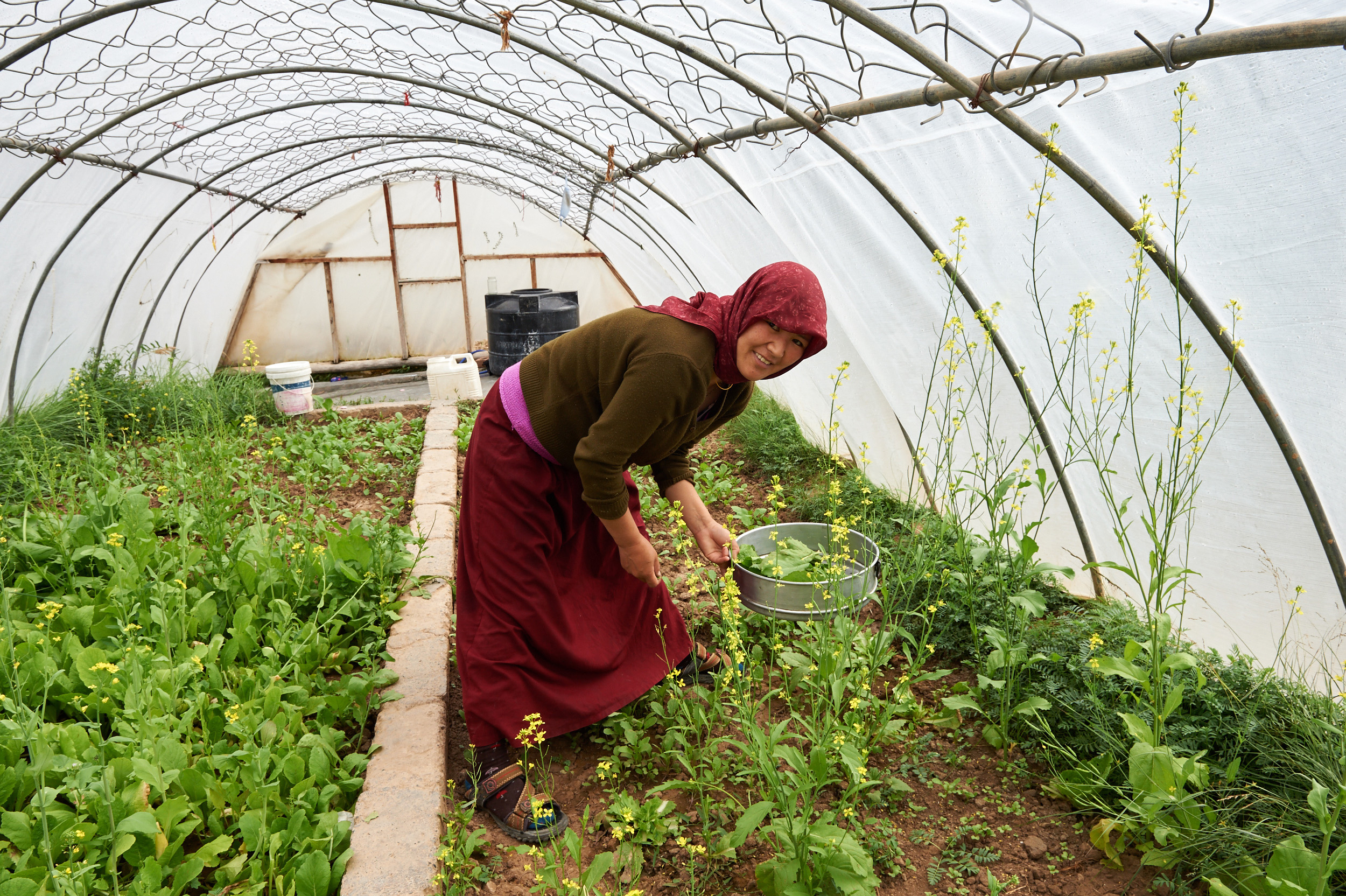
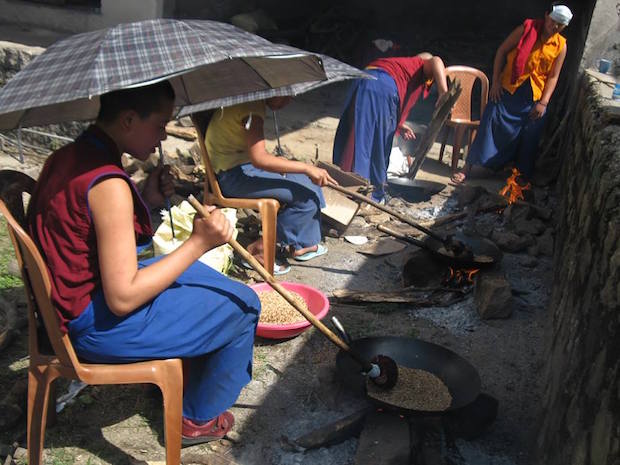

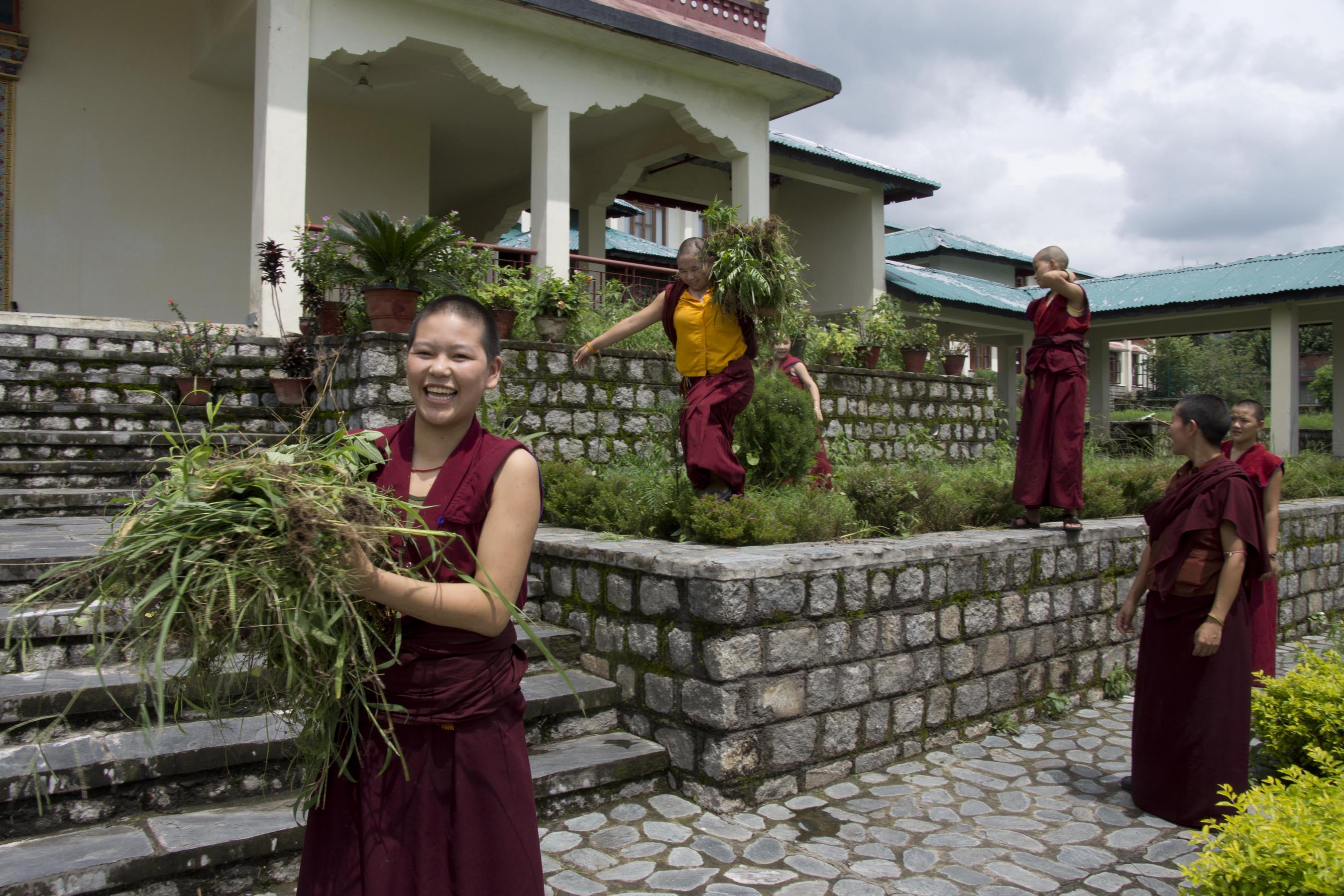

Thanks TNP for the wonderful pictures of the Tibetan Nuns Project at work at the various Nunneries.
Thank you for your lovely comment, David. We’re working on Part 2 of the post right now and will share it soon. Huge thanks for your kindness and support and best wishes from everyone at the Tibetan Nuns Project.
Thank you for your very informative and uplifting website. There is much more of it for me to read, which I am looking forward to.
It was mentioned on one of the webpages that the nuns study computers. Seeing the very basic life in the nunnery, this was both a surprise for me and heartening to here. Such knowledge may be of help for some to make their way successfully through life. I was formerly a college instructor in the computer field and worked many years for large companies, helping them with their server computers and networks. If it is possible, I would very much like to help your students with any questions they might have. I don’t know how this might work, but perhaps with the advice of teachers and administrators we can find a way.
Surely the nunneries have more pressing problems than computer courses, but this is the only way I can think of at the moment that I can lend a hand.
Thank you for your assistance.
Thank you, Kenneth, for your comment and your very kind offer. We’re passing on your words to our Executive Director and will get back to you. There’s quite a disparity in the different nunneries, in part because of their location. The most advanced nunnery in terms of education is Dolma Ling Nunnery near Dharamsala, founded and built by the Tibetan Nuns Project. There some of the nuns have received computer and media training from volunteers and those nuns have been training other nuns. They may indeed have server and network questions. Thank you, Kenneth. We’ll email you ASAP.
Could you possibly show some photographs of Geden Choeling nunnery too? That is where I sponsor two nuns, one of which has just become a geshema!
Thank you for your comment and support, Karen. We’ll make sure we have at least one from Geden Choeling in Part 2 of our daily life blog. Unfortunately, we don’t receive a lot of photos from Geden Choeling Nunnery and that is something that the nuns are working on. If and when we do receive some we will absolutely highlight them through a blog post or through Facebook. You’ll be pleased to know that the cover photo for our 2017 Calendar is of Geden Choeling nuns. 🙂
I appreciate you taking the time to share this information about these activities, supported by the good work of the Tibetan Nuns Project. I’m keenly interested in Buddhist nuns’ empowerment and social transformation, and look forward to seeing and reading more. Keep up the good work.
Thank you for your kind words, Kat. We’re so glad that you liked the blog post. We’ll be posting Part 2 soon with a bit more on nuns’ empowerment and leadership roles in the nunnery. Thank you so much for your support!
What is necessary to be a practicing
Buddha’s nun?
Dear Maite, We have some information about studying and becoming a Tibetan Buddhist nun in our “Frequently Asked Questions” section here: https://tnp.org/youcanhelp/faq/
This is truly inspiring. Such institutes are perfect examples as how a good and why a good education. is important. I have a deep interest in Buddhism and firmly believe in women empowerment and girls education.Surely it will help me in my small effort for the rural girl education.THANKS FOR SHARING SUCH VALUABLE INFORMATIONS. #RESPECT